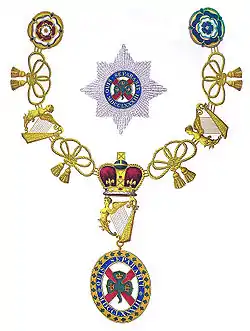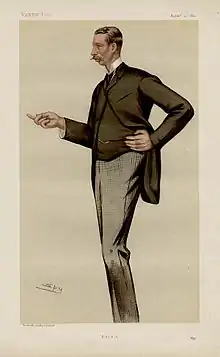Bernard FitzPatrick, 2nd Baron Castletown
Bernard Edward Barnaby FitzPatrick, 2nd Baron Castletown, KP, CMG, PC (I) (29 July 1848 – 29 May 1937) was an Anglo-Irish soldier and Conservative Member of Parliament.


Biography
Life
Castletown was the son of John FitzPatrick, 1st Baron Castletown, and his wife Augusta Mary (née Douglas), and was educated at Eton and Brasenose College, Oxford.[1]
He was appointed High Sheriff of Queen's County in 1876. He served in the Life Guards and fought in Egypt in 1882. He also sat as Member of Parliament for Portarlington from 1880 to 1883, when he succeeded his father in the barony and entered the House of Lords. He served as lieutenant colonel in command of the 4th (Militia) Battalion of the Leinster Regiment (Queen's County Militia) from October 1899, and was the first to outfit them with Irish bagpipers.[2] In February 1900 he left for South Africa,[3] where he was posted on special service during the Second Boer War. In recognition of services during the war, he was appointed a Companion of the Order of St Michael and St George (CMG) in the South African Honours list published on 26 June 1902.[4]
In early 1902 he took part in a special diplomatic mission to promote British interests in Morocco.[5]
Along with Theodore Roosevelt and Douglas Hyde and others, he was elected honorary Vice President of the Irish Literary Society of New York in 1903.[6] In 1905, he proposed a tillage farming plan along the lines of Ireland's old clan system.[7] Castletown was later Chancellor of the Royal University of Ireland between 1906 and 1910.
Theft of the Irish Crown Jewels

The Irish Crown Jewels were discovered missing on 6 July 1907, four days before the start of a visit to the Irish International Exhibition by King Edward VII and Queen Alexandra, at which was planned the investiture of Bernard FitzPatrick, 2nd Baron Castletown into the Order.[8] The theft is reported to have angered the King, but the visit went ahead.[9] However, the investiture ceremony was cancelled. Also stolen were the collars of five Knight Members of the Order. The following year in 1908 he was made a Knight of the Order of St Patrick and admitted to the Irish Privy Council. His banner still hangs in St. Patrick's Hall in Dublin Castle.[10]
Family and Death

Lord Castletown married the Hon. Emily Ursula Clare St Leger, daughter of the 4th Viscount Doneraile, in 1874. The marriage was childless. Lady Castletown joined her husband in South Africa in early 1900, when he was posted there during the Second Boer War.[11]
He died on 29 May 1937 at Granston Manor, aged 87, when the barony became extinct.[12]
Celtic Association
Given his descent from the Mac Giolla Phádraig dynasty, kings of Osraige, it was not surprising that Castletown was particularly interested in Celtic heritage, and was among the founders of the Celtic Association, an organisation concerned with the preservation of the languages, literature, music, dress and customs of the Celtic peoples. In 1900, the Celtic Association was set up in Dublin with Castletown as president and E.E. Fournier as secretary. The Celtic Association is mainly remembered for the three Pan-Celtic Congresses it organized: the first in Dublin in 1901, the second in Caernarfon in 1904, and the last in Edinburgh in 1907.[13] The first Congress had been scheduled for 1900, but had to be postponed when Castletown was called to service in the Boer War. The Association was not without its detractors, in part because many of the Irish sympathized with the Boers.
Originally made up of representatives from Ireland, Scotland, Wales, Brittany, and the Isle of Man; Cornwall was added in 1904.
References
- Colley, Mary. "Lord Castletown Papers", National Library of Ireland
- "Archived copy". Archived from the original on 16 May 2015. Retrieved 9 September 2015.CS1 maint: archived copy as title (link)
- "The War - embarkation of troops". The Times (36066). London. 15 February 1900. p. 4.
- "No. 27448". The London Gazette (Supplement). 26 June 1902. p. 4195.
- "Latest intelligence - Morocco". The Times (36663). London. 13 January 1902. p. 6.
- https://books.google.com/books?id=vklQAQAAMAAJ&pg=PA181&lpg=PA181&dq=lord+castletown+in+new+york+city&source=bl&ots=To9rk0e8mM&sig=ACfU3U0qxhvWm1VBdPDo-kGiyg187Khiig&hl=en&sa=X&ved=2ahUKEwiz_8yB8IHpAhWHGc0KHSWcBCoQ6AEwAXoECAoQAQ#v=onepage&q=lord%20castletown%20in%20new%20york%20city&f=false
- http://www.tara.tcd.ie/bitstream/handle/2262/3698/jssisiVolXi339_351.pdf?sequence=1&isAllowed=y
- "The Illustrious Order of the Knights of St. Patrick" Archived 11 May 2013 at the Wayback Machine, Dublin Castle official website. Retrieved 23 April 2016
- Legge 1913, p.55
- Photograph of banners in St Patrick's Hall by M Strasser
- "Court Circular". The Times (36091). London. 16 March 1900. p. 6.
- "Lord Castletown Of Upper Ossory." Times [London, England] 1 June 1937: 21. The Times Digital Archive. Web. 8 Sept. 2013.
- Lord Castletown. "Address to the Pan-Celtic Congress of 1907", Scotia, St. Andrew's society, 1907
External links
| Wikimedia Commons has media related to Bernard FitzPatrick, 2nd Baron Castletown. |
- Index of the Lord Castletown Papers
- NLI links to Castletown Papers
- Hansard 1803–2005: contributions in Parliament by Bernard FitzPatrick
- History Ireland article on the life of Lord Castletown
- Index of published books authored by Bernard FitzPatrick, 2nd Baron Castletown
- Celtia: A pan-Celtic monthly magazine featuring the activity of Lord Castletown
| Parliament of the United Kingdom | ||
|---|---|---|
| Preceded by Lionel Dawson-Damer |
Member of Parliament for Portarlington 1880–1883 |
Succeeded by Robert French-Brewster |
| Peerage of the United Kingdom | ||
| Preceded by John FitzPatrick |
Baron Castletown 1883–1937 |
Succeeded by (extinct) |